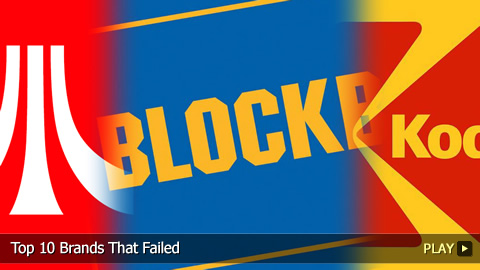Top 10 Brands That Failed

#10 – Lehman Brothers (1850-2008)
Kicking off our list is the largest bankruptcy in United States history. Both a casualty and a cause of the subprime mortgage crisis, this financial services firm was a victim of its own greed. Losses piled up, stocks took a nose-dive, but the government decided not to pass the burden onto taxpayers. Lehman Brothers was the biggest, but definitely not the only, company to fail during this recession.
#9 – Joseph Schlitz Brewing Company (1858-1982)
Schlitz was “the beer that made Milwaukee famous,” and during the early twentieth century it was a top beer in the U.S. But they changed the formula to save money, and it was a disaster. Go figure. After some devastating workers strikes, Schlitz was sold and faded from popularity. Today, the brand is owned by Pabst, who has recreated the original recipe and is selling nostalgia in a bottle.
#8 – Atari, Inc. (1972-1984)
Arcade games would never be the same after Atari and Pong. Atari also had one of the most popular consoles available; but consumer confidence plummeted thanks to a market full of crappy games, and Atari’s “E.T.” was at the top of that list. The ensuing video game crash of 1983 claimed many victims, including Atari. While the name still exists today, it is not the powerful company of yesterday.
#7 – Circuit City (1949-2009)
Electronics superstores followed their roadmap, but that wasn’t enough to keep Circuit City afloat. Inconvenient locations, bad customer service, and not targeting gamers were just some of their mistakes. However, they were still the number two electronics store in America when they filed for bankruptcy in 2008, then liquidated their assets and closed all stores. RadioShack is a similar company whose stock prices imply is on a similar path.
#6 – Blockbuster (1985-?)
Technically, this brand hasn’t fallen off the face of the Earth… Yet. But, failing to adapt to changing trends, new services like Netflix and escalating internet piracy mean Blockbuster is likely uttering its final death rattle. Here are the recent headlines: 2010 – bankruptcy, 2011 – bought by Dish Network, 2012 – gave up competing with Netflix. The end of late fees did nothing to stop the end of this company.
#5 – Research In Motion (1984-?)
RIM targeted professionals with their BlackBerry smartphone. But once the iPhone came to town, CrackBerry was decidedly less addictive. By sticking with what made them famous, and not focusing on games like Apple, they sealed their fate: earnings dropped, CEOs left and things looked bleak. But the booming smartphone market means that, by pursuing emerging markets like South America and Africa, RIM could have a bright future after all.
#4 – Oldsmobile (1897-2004)
Olds was a pioneer in many respects, and one of the oldest auto brands around when General Motors shut it down in 2004. It was the first of many brand deaths at GM: Hummer, Pontiac, and Saturn all met their ends during the Chapter 11 reorganization. Ironically, it was competition from other GM brands that helped lead to the downfall of Oldsmobile.
#3 – Kodak (1889-?)
This company’s “Kodak moment” is long over. In its heyday, Kodak dominated the U.S. film and camera markets. They practically invented the digital camera, too, but waited too long to pursue the technology because they worried it would kill film sales. In 2012, they filed for bankruptcy, sold off many divisions and stopped making digital cameras altogether. Polaroid almost met the same fate, but nostalgic hipsters kept it alive.
#2 – Woolworth’s (1879-1997)
The Woolworth brothers and their chain of five-and-dime stores established the sales, merchandising, and customer service standards in practice today. By the company’s hundredth anniversary it was the world’s biggest department store chain. But mounting pressure from competitors like Wal-Mart caused its decline. Woolworth’s was officially declared defunct in 1997, but it still exists today under the name Foot Locker.
#1 – Pan American World Airways (1927-1991)
Taking the top spot on our list is the “World’s Most Experienced Airline.” Innovations, unparalleled luxury, and hot stewardesses made Pan Am an industry leader and a symbol of American pride. However, a deadly terrorist bombing, plus increasing competition and fuel prices after the Gulf War took their toll: The company folded in 1991. Twenty years later, Pan Am inspired a nostalgic TV show… Which also failed.
Do you agree with our list? Which of your favorite brands has failed? For more entertaining top 10s, be sure to subscribe to WatchMojo.com.